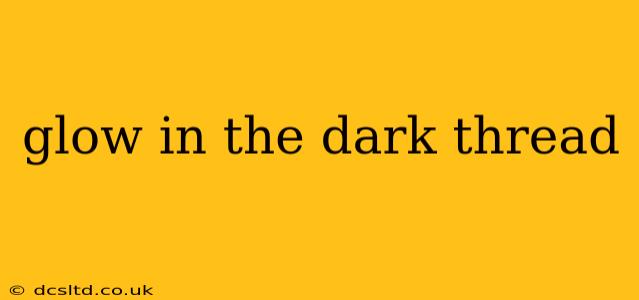Glow-in-the-dark thread has become increasingly popular for crafting unique and eye-catching projects. From clothing and accessories to home décor and embroidery, its versatility allows for endless creative possibilities. This guide delves into the world of glow-in-the-dark thread, exploring its types, applications, and considerations for successful projects.
What is Glow in the Dark Thread Made Of?
Glow-in-the-dark thread achieves its luminous effect through the incorporation of phosphorescent pigments. These pigments absorb energy from light sources (sunlight, UV light, etc.) and then slowly release this stored energy as light over several hours. The specific composition of these pigments can vary between manufacturers, affecting the brightness and duration of the glow. Common base materials for the thread itself include polyester, nylon, or cotton, often chosen for their strength and durability.
How Long Does Glow in the Dark Thread Glow?
The duration of the glow depends on several factors: the intensity and duration of the initial light exposure, the type of phosphorescent pigment used, and the environmental conditions (temperature and humidity). Generally, you can expect a glow lasting from several hours to a full night, with the brightness gradually diminishing over time. More intense charging with UV light will result in a longer and brighter glow.
What Affects the Glow Time of Glow-in-the-Dark Thread?
This question is frequently asked, and the answer is multifaceted. Several factors contribute to the glow's longevity. Firstly, the quality of the phosphorescent material is key. Higher-quality pigments will retain and release light more effectively, leading to a longer glow. Secondly, the intensity and duration of the charging period significantly impact the glow time. Exposing the thread to bright sunlight or a UV light source for an extended period will maximize its glow potential. Finally, environmental conditions play a role. High temperatures can accelerate the decay of the glow, while humidity may have a minimal impact depending on the thread's protective coating.
What are the Different Types of Glow in the Dark Thread?
Glow-in-the-dark thread comes in various forms, each with its own characteristics. You'll find it in different colors (though the glow itself is usually a pale green or blue), thicknesses, and materials. Some brands also offer specialty threads designed for specific applications like embroidery or machine sewing.
What is the Best Glow in the Dark Thread for Embroidery?
The best glow-in-the-dark thread for embroidery will depend on the fabric you're using and the desired effect. A finer thread is generally better for intricate designs, while a thicker thread might be more suitable for bolder statements. Polyester threads are often favored for their strength and ability to withstand repeated washing. Always check the thread's specifications to ensure it's suitable for your chosen embroidery technique.
Where Can I Buy Glow in the Dark Thread?
Glow-in-the-dark thread is readily available from various sources, including online retailers like Amazon and Etsy, craft stores, and specialty sewing supply shops. Comparing prices and checking reviews before purchasing is recommended to ensure you're getting a high-quality product.
Where to Buy Glow in the Dark Thread for Embroidery?
The same sources mentioned above – online retailers, craft stores, and specialized sewing shops – are all excellent places to source glow-in-the-dark thread for embroidery projects. Look for threads specifically marketed for embroidery to ensure they have the right properties for fine needlework.
How to Use Glow in the Dark Thread
Using glow-in-the-dark thread is similar to using regular thread, though there are a few considerations. It's important to fully "charge" the thread by exposing it to a light source before use to maximize its glow. When sewing, be mindful of the thread's strength and thickness to avoid breaking it or damaging your needle.
This guide provides a comprehensive overview of glow-in-the-dark thread, enabling crafters to confidently incorporate this unique material into their projects. Remember to always follow the manufacturer's instructions for optimal results.
